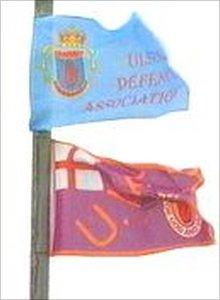Number of paramilitary flags in NI in July half
- Published

The report said that the number of flags had fallen
The number of paramilitary flags being flown on main roads in Northern Ireland during July has more than halved, according to new research from Queen's University Belfast.
The report, Public Displays of Flags and Emblems in Northern Ireland, was published by the Institute of Irish Studies at Queen's.
It reports that the figures are down from 161 flags in 2006 to 73 in 2009.
The largest proportion of flags flying in July 2009 belonged to the UVF.
The study is funded by the Office of the First Deputy First Minister to evaluate the creation of shared space and the effectiveness of the multi-agency Flags Protocol, which was introduced in 2005.
On average, over 4,000 flags are put up on lampposts and houses in town centres and on arterial routes every July.
Surveys conducted in July and September over the last four years reveal one third of the flags put up along main roads in Northern Ireland over the summer months are still flying at the end of September.
The surveys found that those flying from lampposts were often not removed and were left to become torn and tatty over winter months.
Paramilitary
The surveys found the vast majority of the flags flying represent the unionist or loyalist tradition.
During July 2006-09, the average number of unionist flags was 3,868 compared with 245 nationalist flags.
During September, the average number of unionist flags was 1,411 compared with 505 nationalist.
At Easter, two thirds of the flags on arterial routes were unionist.
A previous study conducted by Queen's, The Northern Ireland Life and Times Survey 2008, revealed over a third of people said they were less likely to shop in neighbourhoods with loyalist and republican flags and murals.
The same study revealed that 83 per cent of people in Northern Ireland do not support the flying of flags from lampposts in their area and that over half of respondents believed the Union flag and Tricolour were usually put on lampposts by paramilitary groups.
The Northern Ireland Life and Times Survey also showed some reduction in how many people feel intimidated by such displays.
In 2003, 21% of people said they had felt intimidated by loyalist or republican murals and flags.
In 2008, 13% of people were intimidated by republican displays and 15 per cent by loyalist displays.
Legitimate
Dr Dominic Bryan, Director of the Institute of Irish Studies at Queen's said:
"Over the last thirty years, the tradition in some areas of Northern Ireland of flying flags on houses appears to have declined, while there has been an increase in the hanging of flags from lampposts.
"Instead of celebrating identity, tattered and torn flags are left to demarcate territory.
"In Northern Ireland, where national identity is so keenly felt, this would seem to indicate that in actual fact the national flags are treated with little respect.
"There is a difficult balance to be struck between legitimate expressions of identity and prolonged displays that lead to greater territorial divisions and potential community relations problems, which can ultimately have detrimental economic effects.
"We hope this research will contribute to an informed debate on how expressions of identity can be managed to foster greater respect between people